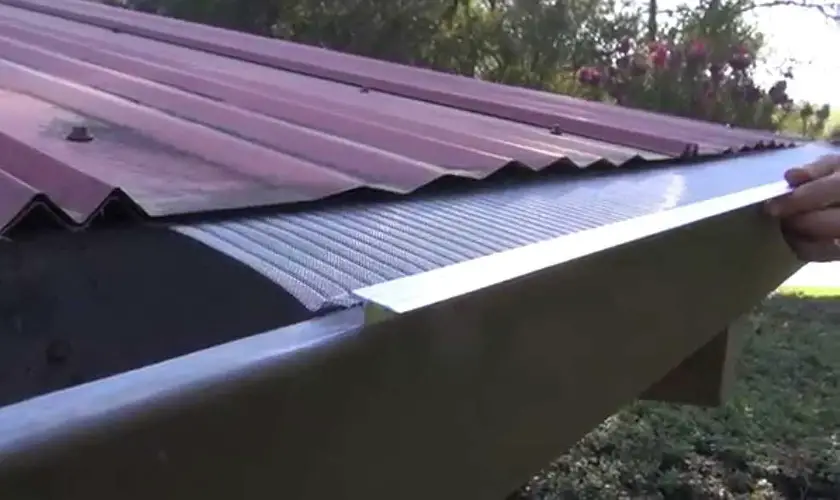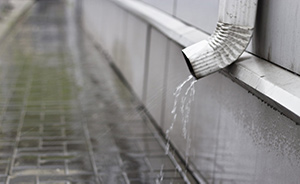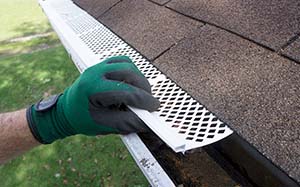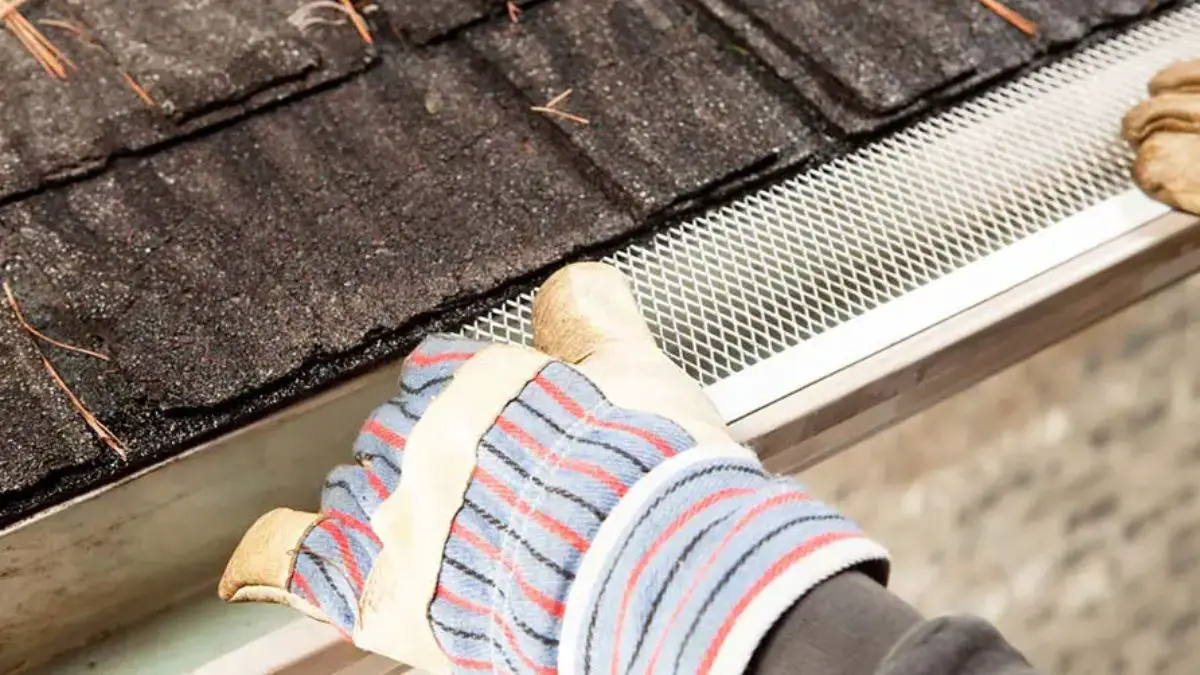
Gutter guards have a lot of advantages. That’s why many people consider installing one. It usually consists of sheets with holes that filter the debris while allowing water to flow freely into the gutter, through the downspout, and down the drain. We often see gutter guards attached perfectly to asphalt shingles, but what about metal roofs?
Generally, gutter guards can work with metal roofs. Since lifting the metal roofing edge is not an option, you’ll want a gutter guard installed directly on the gutter pipe. You’ll also want a gutter guard that lays flat and is not raised above the metal roof to prevent backflow behind the gutter, which can rot the fascia board.
This article discusses gutter guard types, how to choose the right kind, and the advantages and disadvantages they offer homeowners. It also provides tips on installing gutter guards on a metal roof.
How to Choose Gutter Guards for a Metal Roof
Gutter guards vary in suitability for different roofing materials. For example, nylon gutter guards tend to be more snow and ice accumulation resistant. However, they may not be the best fit for a metal roof.
Typical metal roofs are durable, stylish, fire-proof, relatively low maintenance, and robust enough to withstand severe winds and prolonged wear and tear. However, metal roofing may be more prone to corrosion in some places, such as industrial areas. And the colors they consist of may determine their ability to absorb or repel heat.
So, to choose the best gutter guards for your metal roof or to determine whether or not you should install gutter guards, consider these essential factors first to know what’s best for your metal roof:
1. Material Composition
Metal roofing is a general term used to define various metal roofs. These include copper, tin, aluminum, and steel roofs. And some of them come in the form of sheets or panels. However, others are in the form of tiles or shingles.
It is crucial to consider the materials your gutter guards consist of because not all of them will be suitable for your metal roof. Each material will vary in appearance, durability, and cost, among other things.
Also, some may rust much faster, which would stain your water or compromise the structure of your gutter system. Generally, in industrial areas, corrosion will occur earlier.
Stainless steel, aluminum, and copper are the most popular materials for metal roof gutter guards. They tend to be pretty tough, durable, and stylish. They are also naturally resistant to rust or are treated to prevent it. Unfortunately, they have the price to match.
So, you may want to also consider gutter guards with plastic, nylon, or foam as their primary constituent material. However, remember that such guards don’t age well and will degrade faster.
2. Aesthetic Impact
Curb appeal refers to how attractive your home would be to a buyer looking at it from the outside. Good curb appeal implies a house makes an excellent first impression on people. And it matters because a home with amazing curb appeal can increase its value by an average of seven percent.
You should ensure that the gutter guard you select matches your existing metal roofing. But you can also choose gutter covers or screens that sit flat on the gutter so they are invisible from the ground.
For example, if you have steel roofing and want visible gutter guards such as the surface tension, micro-mesh, or screen ones, it would make better sense to find those made from steel or aluminum to match your roofing.
Alternatively, you can find those that can hide within your gutters and out of sight. Examples are foam or brush-style gutter guards that you can insert within the gutter troughs.
3. The Size of Your Gutter Guards
How big your gutter system is may impact your type of gutter guard. That is because the size of the gutter guards you eventually need will affect how much time and energy you spend installing them and how costly they are.
Most gutter guards have lengths of three to eight feet and widths of four to six inches.
To measure how much gutter guard material you need, you may have to climb up your ladder and measure the width of your gutter system. Consider the measurements from the back where the gutter meets your home to the outer edge. And remember, most gutter troughs will be about five inches wide.
Once you get the width, you must get the length of your entire gutter through. Also, allow extra length if you make any mistakes during installation. And then, based on these measurements, you can determine which gutter guard would be most suitable for your needs.
For example, if you are not in the mood to pay a professional roofing contractor and want to save money, you could opt for PVC or vinyl mesh gutter guards that you can easily insert under your metal roof shingles or snap into place.
4. The Cost of Purchasing Gutter Guards
It is always wise to have a budget when shopping for gutter guards. It will guide your buying choice to ensure you get what you need without running out of money.
Expect to spend anywhere from $300 to $3,500 to install gutter guards for your home. The price variation depends on the quality and type of material, installation costs, and the gutter cover design.
For example, PVC screens cost anywhere from $0.6-$1.5 per linear foot, while steel screens cost $1.5- $3.5 per linear foot. But if you were to consider the gutter guards in terms of design, then expect to pay $1.75- $2.5 per linear foot for micro-mesh screens, $2.5-$3.5 for foam or brush-type gutter guards, and $3.5-$6.5 per linear foot for the reverse curve versions.
Where professional labor is concerned, you will need to pay an additional $2-$4 per linear foot for handyman services or $8-$12 for the services of an expert gutter installation company.
5. The Maintenance Gutter Guards Require
The ultimate goal of gutter guards is to reduce the amount of debris that gets into the gutters, thus cutting down on bi-annual maintenance. So, how often you need to maintain your gutter guards usually matters.
Before replacing them, you can use aluminum and brush-style gutter guards for 10-20 years. On the other hand, its micro-mesh counterpart can last 12 years, provided it consists of sturdy metal. The surface tension versions can last up to 20 years.
However, plastic will only last three to six years. And while foam will begin to degrade quickly, when you take care of it well, it can last as long as ten years. As for steel, it can last seven to 10 years.
Of course, it would help to take care of your gutter covers or screens regularly to keep them in good shape. For starters, brush gutter guards may need cleaning up to twice a year. Perforated gutter guards, mesh guards, and surface tension versions may require a clean-up once or twice annually.
How to Install Gutter Guards on a Metal Roof
Once you have considered all the available gutter guards and settled on one, you can install them. Below are simple tips you can follow during the process.
- Set your budget: the budget should be based on your needs and financial abilities. Remember, various factors like quality, choice of material, and brand will affect the overall costs of gutter guards. So, it would be best to set a reasonable range instead of one fixed price to cater to the unknown.
- Take measurements: measure the length and width of your gutter system, including the downspout sections. That will give you an idea of the approximate length and width of the gutter guards you should find. And then, add an allowance to cater for installation errors of, say, 10 percent extra.
- Do the math: considering your budget and the number of gutter guards you need, consider what kind you can afford. Also, consider whether your guards of choice would require professional installation. If that is the case, you should also calculate the installation costs per linear foot and make sure they fit within your budget. If you do not know their charges, it will help to ask for several quotes from local handymen.
- Get all the necessary supplies: if your gutter guards need some supplies, ensure you have everything. You can buy or rent these. Alternatively, you can borrow what you need from family and friends. You may need non-slip shoes, ladders, cleaning fluid, gloves, tape measure, hammer, drill, circular saws, metal cutting scissors, etc.
- Buy the gutter guards: buying the necessary covers or screens early would be wise to account for unnecessary delays.
- Clean the gutters: it makes no sense to cover dirty gutters with accumulated debris. So, thoroughly clean the entire gutter system, including the downspout.
- Read the instructions: if you intend to install gutter guards, start by reading the manual carefully. Remember, different products will have varying manuals. And don’t start until you have understood the information.
- Install the gutter guard: if you opt for a drop-in gutter guard like brush-type or foam, cut or use the correct size, drop it into the gutter, and voila!
Where screens are concerned, carry each panel up the ladder to the gutter section you are working on, place it on top of the gutter, make necessary measurements and mark the placement areas, and secure the internal end by putting it underneath a metal roof. You can unscrew the last screw at the edge of the roof to enable you to insert the screen. Then you can screw it back again.
Alternatively, you can screw the internal end of the screen onto the top of the roof edge and apply silicone on the screw heads to prevent any water leakages. And then, you can snap the outer part onto the gutter lip or lock it over it.
Types of Gutter Guards
Gutter guards are items that homeowners install over their gutters to reduce or eliminate debris that gets into them. And the debris may include animal droppings, leaves, and twigs, among other things.
Several types of gutter guards exist. It would be best to learn the options available before determining which ones work best for a metal roof.
Below are the six primary types of gutter covers you need to learn about.
1. Screen or Perforated Metal Guards
Perforated or screen gutter guards are standard and contain plastic or metal sheets full of holes to filter the debris.
These sheets are designed to be attached to roof shingles to go over the gutter. Generally, the smaller these holes are, the better the screens work because they will keep most debris out. But the hole sizes have a limit.
The roof shingle weight will hold the perforated gutter guard in place throughout the gutter trough. So, they are easy to install because minimal tools are needed.
Unfortunately, interfering with roof shingles in this manner may void their warranty. Also, the screens may become dislodged in extreme weather events because nothing else is holding them down. And they would be rendered useless.
2. Micro-Mesh Gutter Guards
People usually refer to screens with smaller openings as micro-mesh gutter guards. Such guards can block even the windblown sand, thus making them more effective at keeping gutters clean and debris-free.
For micro-mesh gutter guards, you install them under the roof shingles as you would perforated metal guards. But you can also snap the guard onto the gutter directly to install them. Also, you could attach flanges to the fascia to put them in. These may sort out some warranty issues and reduce the chances of strong winds dislodging them.
3. Non-Gutter Cover
Non-gutter covers are thin louver covers that replace your gutter. And then, instead of allowing water to flow through the downspouts to the drain, they will directly divert the water off the roof.
4. Reverse Curve Gutter Guards
Reverse curve gutter guards allow water to flow over them, around a downward-facing curve, and through a narrow slit into the gutter trough but force leaves and other debris to slide off its edge onto the ground.
Reverse curve gutter guards are also known as surface tension guards. You can install them over the existing gutters by attaching them to the roof fascia at the correct angle (similar to the roof slope).
If you do it wrongly, all the water will slide over the cover onto the ground instead of the designated areas. If mounted high on one side, reverse curve gutter guards may create debris dams and increase the accumulation of debris inside the gutter systems. So, you may want to consult a professional if you opt for this gutter guard.
5. Bottle Brush Gutter Guards
Brush-style gutter guards consist of polypropylene bristles facing upwards and extending from a metal wire core to enable debris to settle upon them. At the same time, water flows through the gutter system.
These oversize pipe cleaners usually rest in the gutter and are pretty easy to install. The core is flexible and can be fitted within tight spots. Also, the gutter guards do not require screws or fasteners to attach them to the gutters.
It is also worth noting that brush guards prevent snow compaction. As a result, the snow will melt and run off faster.
6. Foam Type Gutter Guards
Foam gutter guards consist of foam that you will cut to size and fit into your home’s gutters. The foam is usually porous polyurethane. It works by ensuring that debris does not accumulate within your gutter system.
While foam gutter guards are affordable and easy to install, they can provide an excellent environment for plants to grow and quickly waterlog in areas of high precipitation.
Also, if the debris accumulates on top or roof shingle materials pass through, the gutters will still become clogged. In addition, foam is a fire hazard and becomes brittle within two years.
The Benefits of Gutter Guards
While gutter guards are not maintenance-free, they offer several benefits worth considering. Some of them include the following.
- Ease the gutter cleaning process: when gutter guards function as they should, they reduce the amount of debris accumulated within your gutter. As a result, you will spend less energy, money, and time cleaning your gutters each year.
- Enhance water collection: the more debris you have in your gutters, the less water flows through them. And in turn, this reduces the water that flows through your downspouts into your cisterns. However, if there is less debris due to gutter guards, water will flow faster through your gutter system. And you can collect more water for your use.
- Improve rainwater quality: a well-functioning gutter guard should minimize the amount of debris that gets into your gutter system, including plant material and animal droppings. Doing so, improves the quality of water and makes it more usable.
- Improves structural integrity of the home: debris accumulating within the gutter tends to encourage standing water, which may cause rust or leakages through the roof and walls into your home. During winter, that water will cause ice dam formations. So, if your gutter guards reduce this debris, they will lessen the chances of water damage because there would be less clogging, thus safeguarding the integrity of your home.
- Reduces animal infestation: birds and rats may use accumulated debris to make their homes within any gutter system. Unfortunately, the presence of these animals may attract other predators like snakes or bring various diseases through their droppings. But when you cover your gutter and reduce its debris, you enhance your safety by keeping such animals away.
- Reduce fire hazards: in areas prone to fires, a tiny ember can light up the debris on your gutter and burn down your entire home. So, instead of risking that kind of scenario, installing gutter guards that reduce debris within the gutter system would be safe, thus cutting down on fire hazards to keep your home safer.
Why Gutter Guards Can Be a Bad Idea
Granted, gutter guards offer their fair share of benefits. The main problem with gutter guards is that people think they are maintenance-free and forget about maintaining them. Unfortunately, they also have several disadvantages. And you may want to think about why gutter guards may be a bad idea for your metal roof before you make the final decision.
- Not foolproof: most gutter guards won’t give you what you want if you want to avoid gutter maintenance altogether. You would still need to clean them once or twice a year – though the work will likely be less. However, you could choose to replace your gutters with non-gutter covers. Even so, you would probably exchange gutter cleaning for more yard work because that debris has to go somewhere.
- Expenses can build up: if you are looking for long-term gutter guard solutions, you should expect to pay a hefty price for several types of these products. Both the materials and installations will cost you a pretty penny.
- Voiding of the roof warranty: Suppose the only way for you to install your gutter guard is by putting it under your roof shingles. In that case, you need to tread carefully. It would be best if you consulted the roofing manufacturer to get permission. That’s because this installation may void your roofing warranty and, thus, leave you responsible for future roof repairs.
- Curb appeal issues: some gutter guards may fail or begin to work poorly as time goes by. In such cases, they may cause debris to accumulate on top of them. When that happens, the edge of your roof will look ugly, affecting its overall curb appeal. Also, gutter covers generally tend to be visible from below. If you choose wrongly, you will compromise the overall look of your home even when it functions correctly.
- Compromise structural integrity: when gutter guards fail to work as they should, the debris accumulation or ice dam formation with the extra weight of the guard will cause the gutters to begin sagging. And don’t be surprised in such cases if you end up with more water damage to your home than you anticipated.
- Creates a fire hazard: foam gutter guards may be very flammable. And instead of keeping a fire from your home by preventing debris, they may end up quickening the spread of the fire and rendering you homeless.
- Removal from their position: if you choose gutter guards that do not require secure fastening, they will be dislodged during extreme weather events. As a result, they will fail to do the job you installed them for. And you would still need to clean your gutters and may even need to buy replacement parts. Ultimately, such guards would not give you the returns you were hoping for.
- Maintenance can be challenging: since guards still require cleaning, you may find the process difficult, especially if some debris passes through them. Reverse curve guards tend to be the most challenging in this regard.
Final Thoughts
There is no point in investing so much money in gutter guards if you won’t get any use out of them. Therefore, please choose the best type for your metal roof and ensure you install them correctly.
However, it would help if you managed your expectations and remembered that you would still have to clean them once or twice to extend their life and maintain the structural integrity of your roofing and gutter systems.






